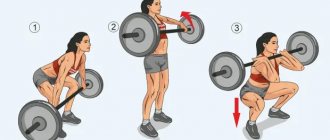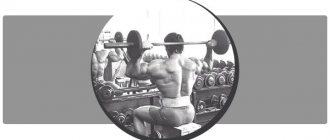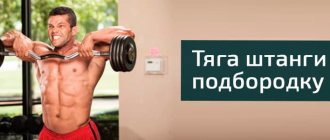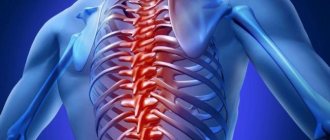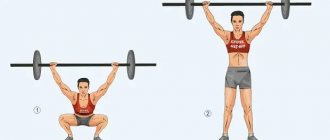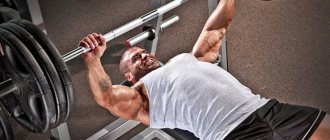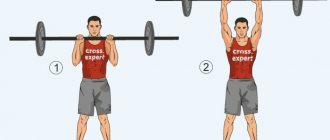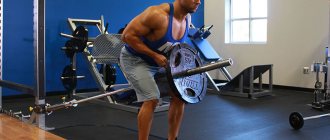Lifting the barbell to the chest is also called clean. Some old school athletes refer to this exercise as the push pull. The essence does not change from this. The movement consists of lifting the apparatus from the platform to the shoulders using the strength of the legs and inertia. It resembles a deadlift in its trajectory, but differs in that during the lift the apparatus is literally lifted onto the shoulders and the body and arms are involved in the movement. The exercise has found its use in multiple disciplines. Weightlifters use it as a special preparatory exercise. Like competitive – CrossFitters. As part of general physical training – those training for basketball, American football and strength and speed disciplines. Some trainers believe that lifts can also be done in fitness. By the way, even in the Hot Iron group lesson there are mini-barbell cleans. After all, this movement helps to quickly burn a lot of extra calories.
Execution technique
Initial position
- The bar lies on the floor, ideally on a level platform. If the ideal is not achieved in your gym, stand so that your pelvic bones are in a plane parallel to the bar; it is not necessary to align your body with the position of the wall;
- The athlete approaches the bar at a distance at which the bar would be projected onto the middle of the arch of the foot, and from this position extends his arms forward shoulder-width apart;
- It is in this position that the palms are lowered onto the bar so that a symmetrical grip is achieved. The athlete stretches his arms by lowering the pelvis slightly down and bending at the hip joint;
- The back tenses along with the arms, there is no need to perform any special tightness here, static tension of the back muscles is enough
Movement
- The barbell is removed from the platform by tension, that is, the arms are stretched, the athlete rests his feet on the platform and sharply lifts the bar off the floor;
- The movement is high-speed, unlike the deadlift;
- At the height of the knee, the legs are pushed off the platform, a light jump is performed and the projectile is detonated;
Note : detonating a projectile is a method of accelerating it, forced acceleration
- The rod, by inertia, flies over the level of the pockets;
- Next, the arms are turned on, and with the help of bending the elbows, the projectile is brought out to the shoulders;
- There are two options: either the athlete goes into a squat together with the barbell, or as soon as the projectile reaches the chest line, the athlete lowers into a light squat and stands up;
- In game sports disciplines, it is allowed to stand up without squatting. A similar technique is allowed in CrossFit. In weightlifting, either a full squat or a third of a squat is performed, but straight leg stand-ups are not allowed;
- In strongman, an incomplete lift is allowed. The athlete brings the bar to the middle of the chest or to the solar plexus, and then rolls it onto the shoulders by bending the back;
- The reverse movement is either dropping the barbell onto the platform, if this is an exercise with a heavy weight, to a repeated maximum, or lowering it. In all cases, it is safer to reset and re-take from the starting position.
Barbell clean - Vladimir Laptev
Errors
- Bouncing the weight off the floor . At the start, the athlete seems to throw the barbell on the platform, after which he begins deadlifting and lifting;
- Hand jerk . If tightening your arms before starting the exercise is a necessary part of the movement, then you don’t need to jerk the projectile with your hands and try to lift it onto your biceps after lifting it. If there is not enough inertia and speed underground, the barbell is simply thrown onto the platform;
- Round lumbar region . Some top athletes start with a rounded chest, or even with shoulders rounded forward. But the lumbar region remains tensely arched, as if inserted into the back;
- Arms bent at the elbows at the start . With this position of the arms, the athlete cannot tighten himself and is not able to lift the barbell correctly;
- Shoulders at different heights . The error occurs due to a violation of posture, which a person cannot control with a shoulder strap;
- Do not bend your knees correctly when trying to pull the barbell with your hands from the deadlift position
Seated biceps curl
The peculiarity of the exercise is that when lowering the barbell you will not be able to completely straighten your elbows, and when lifting it you will not be able to tilt your back back, unless of course it rests against the back of the gymnastic bench.
Each standard standing biceps exercise can be completed with a final sitting approach.
Adviсe
- Good squat cleans can only be achieved if the back is tense, the arms are also tense, and the legs are actively resting and pushing into the platform. The body must be rigid and, as it were, create one structure with the barbell, so relaxed muscles at the start are a mistake;
- The bar initially moves strictly along the shin, then it is depreciated;
- The reverse movement should be absorbed by the knees;
- It is difficult to lift the barbell simply with your hands from the lifting position, so if there is not enough inertia, you should throw the barbell onto the platform;
- The lift should not start from the knee; the appropriate time is when the bar passes the thigh. The removal of the apparatus from the platform occurs smoothly, using the deadlift technique, and the bar slides along the shin;
- The deadlift can be trained on a separate day, but the speed of the clean is much greater than the speed of the deadlift;
- Raising your shoulders slightly as the bar lands on your chest helps soften the impact;
- Do not lower the barbell through your hip, that is, do not rest the barbell on your thighs when attempting to return the barbell;
- Beginners practice the exercise technique with an empty bar or a light stick; there is no point in increasing the weight until the elements are mastered;
- If the athlete is a complete beginner, he should work on shoulder mobility with a plastic stick or light bar;
- Crossfitters must first learn how to do an exercise technically correctly, and only then perform it in a high-repetition mode;
- You cannot focus on the weight in the deadlift when performing cleans. There is some relationship between these weights, but it is not so great, because the exercises differ in dynamics.
Basic mistakes
Beginners often make a number of mistakes when performing this exercise. Here are the most typical ones:
- lack of warm-up, due to which the joints and ligaments are unprepared for the upcoming serious load, especially the joints of the elbow and hand, as well as the hamstrings;
- rounding of the back and lower back - even when using an athletic belt, it is necessary to control their position: the back should be straight, with a natural arch in the lumbar area;
- the weight of the projectile is too heavy, which makes it impossible to technically perform this exercise correctly.
Execution options
- Hanging rise . This option does not allow you to work on the fall phase, but the back on it is activated automatically as soon as the bar is lowered in straight outstretched arms, and therefore the rise from the hang is easier;
- Rise from pockets . It is performed with straight outstretched arms and from the level of the pockets, the goal is to practice undermining and leg movements. This allows you to gain speed, but this variation is not recommended for people with problematic spines and protrusions in the thoracic region.
Lifting the barbell with elbows back
The main feature of the exercise is that the barbell rises straight up, and it is the elbows that move.
The second name of the exercise is the Gironda lift and its main goal is to pump the upper biceps. To learn an exercise, it is better to first practice it in a Smith machine.
Analysis of the exercise
Clean-ups should not be performed without warming up. An adequate warm-up for cleans is not only 5 minutes on the treadmill, but also a complex of any movements that rotate the shoulder outward. You need to perform a series of exercises that externally rotate the shoulder. For example, any variations of a scarecrow, or a simple rotation of the arms backwards with a rubber shock absorber or a jump rope, are adequate for this purpose.
What muscles work
From the point of view of biomechanics, lifting refers to complex coordination and functional exercises that require a coordinated effort of a volumetric array of muscle groups:
- Gluteal;
- Calf;
- Biceps femoris;
- Quadriceps;
- Trapezoidal;
- Abdominal Press;
- Erector spinae muscles;
- Latissimus dorsi muscles.
Proper execution
- Foot placement in this exercise cannot be the same for all athletes. Usually the heels are placed under the pelvic bone, but the actual width of the placement also depends on the separation of the toes. In weightlifting, there is a simple way to identify correct positioning. The athlete is placed on the box and jumps off it. The width at which he lands and the position of the toes that is obtained are the most adequate for a given athlete with his anthropometry. You should not force your toes to the sides or somehow stretch your hips in order to stand wider;
- The position of the hands, that is, the grip, is the projection of the shoulder joint. The lock grip is not recommended for this exercise when it comes to fitness. It is better to perform with a straight grip shoulder-width apart;
- The lock grip is used only in weightlifting. It requires well-developed grip strength, as well as the ability to hold weights with the thumb. This does not happen in one workout, and torn calluses are quite common in this style of training;
- The bar should be close to the body, but it won’t be possible to make a high-quality lift if you press the bar into your shins, so you need to stand so that the bar is in the projection of the arch of the foot;
- The movement should be continuous, there is no need to pause in the middle of the amplitude;
- At the final point of the take, you should raise your shoulders slightly so that the landing of the bar is as soft as possible.
#weightlifting Weightlifting training. Lesson #1 Barbell Clean
Errors
- The knees shift from the line of the toe, resulting in a collapse inward. Doing the lift with the knees slightly apart is recommended for those for whom this is a natural position of the legs;
- The shoulders are tilted back at the start. In this position it will not be possible to make a detonation;
- The bar does not go along the legs but along an imaginary arcuate line;
- In the undermining, a blow is made to the pockets, that is, pushing off with the hips;
- Coordination of movements is impaired, and the athlete simply cannot keep up with the barbell;
- When moving from phase to phase, a cool-down is performed and the athlete drags the apparatus with his muscles
The speed of the lift from the platform is not high; the athlete lifts with force, not technique - the main reason that the lift fails. The lack of tension at the bottom point of the movement does not allow for a high-quality break, the result is a movement in the back, and during the lift the athlete cannot open up - in this case, it is recommended to work with the pull to the knees at a very fast pace in order to master the lift in the next phase.
Important points
The exercise has a number of features that should always be remembered:
- The bar moves strictly along the body, and not along a vertical trajectory.
- There should be no stops between phases of movement. The exercise is performed holistically, with a smooth transition between phases.
- The projectile moves due to the coordinated work of a large number of muscle groups. If any of them, for example, your hips, back or shoulders, are lagging behind, work on their development separately.
Including this exercise in your training program will allow you to develop muscle strength and get a significant increase in muscle mass. The phases of the movement can be practiced separately, and then combined into one movement. It is better to start training with a light weight, and after lifting becomes completely controllable, increase the load.
Spider curl
This variety perfectly isolates the biceps, because there is nowhere to wait for help. Raise the barbell up and pause for a second to create a peak contraction in the biceps.
It also cannot be called mass-gaining and its main task is to form the peak of the biceps and give it a beautiful appearance.
Barbell curl against a wall
The technique is identical to the classic barbell curl with the difference that your back rests against the wall and no matter how much you want to, you won’t be able to lean back.
Of course, the working weight will need to be reduced by about 20%, because the usual weights can no longer be overcome, but the load on the biceps will be more isolated.
You don’t need to do it all the time; it’s enough to do the last approach with this variation.
Lifting the barbell with emphasis on the biceps insulator
To do this, you need a special device - a biceps isolator. The grip required is narrower than in the classic version, and the emphasis of the load falls on the inner part of the biceps.
The biceps isolator will not allow you to lower the barbell completely down, therefore, in contrast to the Gironda lift, the main load falls on the lower section of the biceps.
Reverse grip barbell lift
The exercise is mainly aimed at strengthening the brachioradialis muscles and brachialis, which is located under the biceps and its physical development, increases the biceps, lifting it and giving it additional volume. Of course, the weight of the barbell will be minimal, but the main thing here is to perform the exercise correctly.
The number of repetitions is around 7-8, rest between sets is 1.5-2 minutes. At the lowest point, do not straighten your elbows completely, but when lifting them up, maintain a distance between your hands and the upper chest of at least 10 cm.
Use all types of exercise periodically, which will allow you to train your biceps from different angles, involving all areas of the muscles, even deep-lying ones. Good luck with your training!
